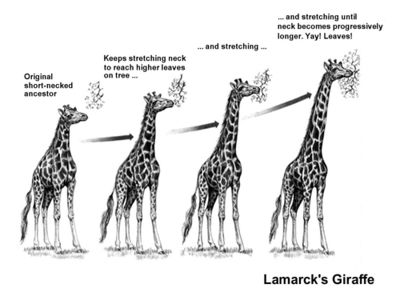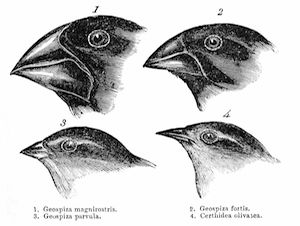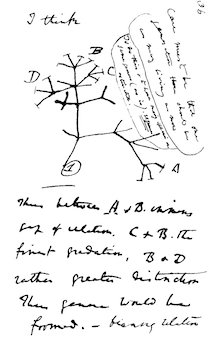Evolutionary Science before Charles Darwin
The few decades preceding the publication of Charles Darwin’s On the Origin of Species in 1859 played an important role in setting the stage for how Darwin’s treatise would be received amongst the general public. It is during this time that the working classes, in Britain and most of Western Europe, as well as America, were developing their own sense of identity. A new class unity was slowly forming, founded upon principles of separateness from the upper classes, or as British historian EP Thompson puts it, “the consciousness of an identity of interests as between all these diverse groups of working people and as against the interests of other classes.”[1]
CLASS, EDUCATION, & EVOLUTION
Crucial to this new consciousness was the recognition of the power of knowledge and education. A combination of factors, ranging from new types of schooling to the wide readership of “penny” newspapers had created a more literate and political working class. The middle and upper classes feared that the tight grip they had on knowledge and its distribution was being loosened by men who had hitherto been mostly apathetic insofar as education and schooling were concerned.
The proper role of science in the community, and to what extent amateurs should be allowed to interfere with and influence this role, was a brand new topic of debate in the 1800s. Before this time, science was the domain of the gentleman amateurs. Generally, those who were without money and class simply did not have the means to study and engage with scientific discoveries. The advent of the printing press and cheap working-class science periodicals during the beginning of the nineteenth century had scientific knowledge locked in a game of tug-of-war between the scientific elite and everyone else. The elite saw themselves as the producers of science; in their minds, they conceived the theories while everyone else (and especially those who were not members of the upper classes) exploited and misunderstood them.
Evolutionary theory was among the hottest scientific topics of nineteenth-century science. While Charles Darwin’s theory of evolution by natural selection is the accepted biological science of today, the idea that each species on Earth did not come to exist through singular acts of creation, but rather evolved from preceding species, was not a new one. But, while many scientifically literate men (and a few women) were aware of evolutionary theories, very few accepted them as fact. Why? Because evolutionary theory came into direct conflict with the Biblical account of creation. There was no escaping religion in the 1800s – Christianity dominated every aspect of society in Britain, America, and most of Europe. And scripture held that God made each species individually, right down to creating man, in his image, vis-à-vis Adam and Eve. Viewpoints that conflicted with such Biblical teachings were met with resounding criticism and censure. Charles Darwin himself went back and forth about whether or not he should publish his findings on evolution – as a member of the landed gentry in England, any semblance of irreligion put his and his family’s social standing at risk.
We should not look at the theories that preceded Darwin’s theory of natural selection as incorrect or superseded, but rather as important and crucial steps on the road to a better understanding of evolution. It is highly unlikely the Darwin would’ve conceived of his theory without referencing the ideas of previous philosophers and men of science, so we should give these ideas their due.
EVOLUTIONARY IDEAS BEFORE CHARLES DARWIN
One of theories that came before Charles Darwin’s was conceived by his own grandfather, Erasmus Darwin, and put forth in a work entitled Zoonomia, published in 1794. This work was part medical manual and part poetry – in it, E Darwin deals with everything from psychology to evolutionary theory, all the while narrating his findings in flowing, beautiful prose. He states: “Would it be too bold to imagine…that all warm-blooded animals have arisen from one-living filament?”[2] Erasmus Darwin suggests a theory of evolution founded upon the idea of the inheritance of acquired characteristics. Essentially, this means that traits an organism acquired during its lifetime (i.e., growing a thicker coat of fur to keep warm in a cold climate) would be passed onto its offspring. This idea, although not popular at the time, was hardly a new one. Philosophers such as Hippocrates and Aristotle had put forth similar theories over 2000 years before Erasmus Darwin published his work.
A little over a decade after Erasmus Darwin’s publication, one of the most seminal works on evolutionary theory was published in France. Jean Baptiste Lamarck set forth the theory of the inheritance of acquired characteristics in his 1809 publication Philosophie Zooloqique. In this work, Lamarck, a French naturalist, held that evolution occurred due to the utility of certain biological characteristics’ use or disuse during the lifetime of an organism, much like Erasmus Darwin’s theory. If certain characteristics/mutations proved useful, those characteristics would be passed onto offspring, and vice versa. Think the giraffe gradually stretching out its neck to reach the higher leaves in the trees, then passing on this “long neck” to its offspring. Although we now know that Lamarck’s theory was incorrect, it should be noted that he was on the cutting edge of biology during his time.
THE ROLE OF GEOLOGY IN EVOLUTIONARY THEORY
Geology was another popular topic of study among gentlemen naturalists of the Victorian era. While studying the geological formations of the earth, most learned men of science felt compelled to reconcile their findings with biblical teachings, as was standard during this time. The Bible held that the earth was 6000 years old, so any and all discoveries made by geologists must somehow fit into this timeframe. “Catastrophism” – the theory that changes in the Earth’s crust resulted from sudden violent and unusual events – was the name of the game during this time as this theory was easily reconcilable with the biblical account of Earth’s creation. This theory held that mountains and valleys were formed during catastrophic events, over a short period of time; these catastrophic events were responsible for the various layers of sediment and fossils. The so-called “gentlemen scientists” of the Victorian era had no problem reconciling their findings with their Christian beliefs, as biblical accounts like Noah’s flood were seen as perfect examples of catastrophic events that had shaped the earth’s crust.

Catastrophism enjoyed widespread popularity among the men of science during the Victorian era until a Scottish lawyer and amateur geologist named Charles Lyell came along. Lyell’s Principles of Geology (1830-33) was perhaps the most important work on geological science ever published. In this three-volume book, Lyell used a slew of geological findings to strengthen his argument for his new theory: Uniformitarianism. This theory changed the very foundation of geological science – Lyell provided almost irrefutable proof that the Earth was older than 6000 years. With Lyell’s theory, the Earth went from being a young planet whose crust was shaped by catastrophic events, to an ancient planet whose layers had developed over vast periods of time. But this didn’t happen overnight. As we shall soon see, the idea of an Earth that was millions, or even billions, of years old was a crucial element in Darwin’s development of the theory of natural selection.
A 22-year-old Charles Darwin read Principles of Geology while on his famous voyage on the ship the HMS Beagle from 1831-1836, and Lyell’s idea of slow changes over immense swathes of time helped set the stage for his own theory of natural selection. The vast majority of Darwin’s ideas on evolution were formed during this journey – this is when he famously visited the Galapagos Islands and compared the beaks of finches. He noted the great variety of finches (and their beaks) over such a small amount of land -- each finch's beak was perfectly shaped for the food it ate and the daily tasks it must perform.
Darwin was a changed man when he returned to England, set on discovering the true laws of nature. He knew his ideas about evolution would not be well received by the majority of “learned” men because of their potential to conflict with religion, but nevertheless, he began collecting proof to bolster his theory of natural selection. It would ultimately take him over twenty years to gather the evidence, and the courage, to publish his findings.
EVOLUTIONARY IDEAS HIT THE MAINSTREAM
While Darwin was hard at work on his theory of natural selection, in 1844, a book entitled Vestiges of the Natural History of Creation was published in London.[3] Giving credit to Darwin’s reluctance to make his own findings known, Vestiges was written by an anonymous author who feared for his own social standing if the “blasphemous” concepts in this book were linked back to him. This work put forth the theory that everything in existence had evolved from some earlier form – this included plants, animals, the solar system, and even mankind. It blended recent theories in astronomy, medical science, geology, and the brand-new science of psychology, and it did so in a way that could be understood by those without a background in science. The work gave credence to Jean Baptiste Lamarck’s previous work on evolutionary theory, but held that Lamarck’s mechanism of evolution (the inheritance of acquired characteristics) was flawed and incorrect. The book was elegantly written – its narrative tied together various scientific theories that had been floating around during the time in an easily readable way.
Vestiges soon became an international best seller, but despite its popularity among the general public, the book was met with resounding criticism from clergymen and scientists alike. The Reverend Adam Sedgwick, who was perhaps the most well known scriptural geologist of the time, said the following of Vestiges: “…our author’s work is not merely shallow and superficial, but utterly false throughout to all the principles of sound philosophy…”.[4] Sedgwick initially surmised, given the book’s disregard of “accepted” scientific knowledge and poor logic, that it had almost certainly been written by a woman – a most scathing criticism at the time. Forty years after its initial publication, a Scottish author and journal editor named Robert Chambers was discovered as the author of Vestiges.
In his early editions of On the Origin of Species, first published in 1859, Charles Darwin remarked that Vestiges was vital in preparing the public for his own theory of evolution by natural selection. In the third edition of Origin, Darwin commented that Vestiges had “done an excellent service in calling this country’s attention to the subject, in removing prejudice, and in thus preparing the ground for the reception of analogous views”.[5] Darwin had actually written down his theory of natural selection in his personal journals the same year that Vestiges was published, 1844, but stalled in publishing his findings, especially after he saw the harsh criticism that Vestiges received from the learned men of science.
Darwin gathered up the courage to publish On the Origin of Species primarily because a naturalist named Alfred Russel Wallace sent him a copy of a manuscript that expounded a mechanism of evolution that was oddly similar to Darwin’s own. It seemed that the two men had independently come to a very similar conclusion – that the primary evolutionary mechanism was the “survival of the fittest”, as it would later come to be known. Darwin and Wallace decided to present their work to the Linnean Society (a sort of gentlemen’s club of natural history) together in July of 1858, but their joint lecture drew little attention. Darwin would finally publish Origin the next year, in 1859. The book was immensely popular – drawing both high praise and brutal censure – but the scientific world would never be the same.
References
- Jump up ↑ Thompson, The Making of the English Working Class.
- Jump up ↑ Darwin, Zoonomia; Or, The Laws of Organic Life, 397.
- Jump up ↑ For an excellent study of this work, see: Secord, Victorian Sensation.
- Jump up ↑ Bosanquet, “Vestiges of the Natural History of Creation”: Its Argument Examined and Exposed.
- Jump up ↑ Darwin, On the Origin of Species by Means of Natural Selection, or the Preservation of Favoured Races in the Struggle for Life, xvi.
Admin, TacoCat and EricLambrecht


